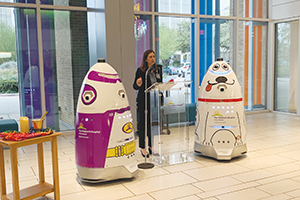By LISA EISENHAUER
If the new security guards patrolling The Children's Hospital of San Antonio look like something that only a kid could dream up, that's by plan.
Lightning Willie and Captain Violet stand about 5 feet tall. Their rocket-shaped bodies sport markings that were customized in consultation with some of the young patients at the CHRISTUS Health hospital. Lightning Willie has the eyes, nose, paws and dangling tongue of a goofy dog; Captain Violet's painted-on uniform has a color scheme to match her name set off by a gold security belt. The pair got off and rolling on their rounds in mid-February.

Alston
Roy Alston, vice president of security for CHRISTUS Health, said the hospital wanted Violet and Willie to fit in with the child-friendly vibe of the hospital, which has panels that cast vibrant colors at night from its 11 stories and a huge mural on the façade that depicts an angel watching over a child.
Behind the playful appearance of the robots is the serious purpose of adding another layer of security at a hospital in the heart of a city churning with car and pedestrian traffic, Alston said.
"We felt as if this technology was something that would allow us to just provide a much safer environment," he said. "Being CHRISTUS Health, we kind of embrace innovation and technology, so we decided to employ it and see how it works out."

Cris Daskevich, chief executive of The Children's Hospital of San Antonio, introduces security robots Captain Violet and Lightning Willie during a ceremony that included a blessing of the robots, which are on patrol duty outside the hospital.
The robots are on programmed patrol courses 24-7 in a geo-fenced area outside the hospital. The robots have charging stations near their patrol areas where they dock for 20-25 minutes three to five times daily.
When they are on patrol, multiple cameras continuously snap photos and take video of their surroundings. Humans at a security post can live monitor the video feeds. If the software detects anomalies that might suggest criminal activity — such as a person in a restricted area of the campus — it alerts human security personnel.
The robots are programmed to detect and avoid both stationary and moving objects, such as pedestrians and cars. Visitors can stop them and, with the press of a button, have a two-way conversation with a human security guard.
In addition to their security work, the robots are ambassadors for hospital visitors. They say "Hello" and "Excuse me" and tell people their names. Over time, Alston said, refinements in their software are planned that will allow them to answer questions like "Which hospital entrance is open at night?"
The robots were designed by Silicon Valley-based Knightscope, a company that has customized security bots for use across the country for several years.
Alston said the robots will never replace their human counterparts and the security they provide. "It's an augmentation," he said of the technology. "What we're really looking at is what the future of security looks like for facilities like hospitals and other places and just being on the forefront of embracing that technology."
Visitors to The Children's Hospital have been delighted when they encounter one of the robots. "Almost all the kids gravitate right towards the robot," he said. "They want to touch it, they want to experience it, they want to take pictures with it."
The robots are programmed to linger long enough for a few questions and a quick selfie, but they don't stick around long before rolling off to resume their patrols.